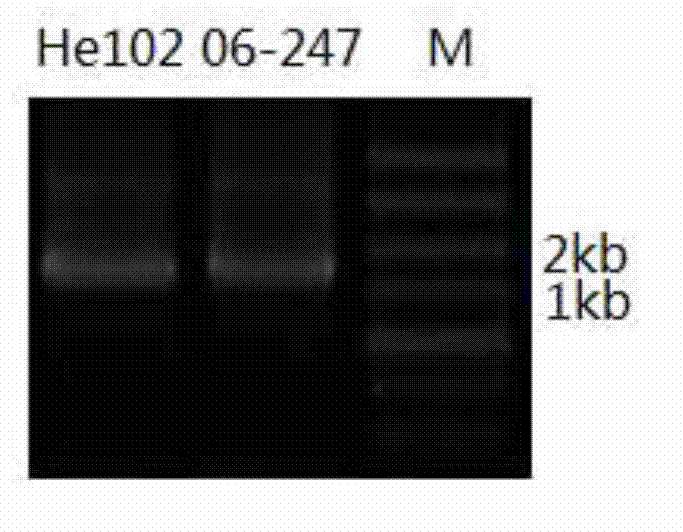Specific molecular marker of deletion mutation of base at site of eIF(iso) 4E.c of Chinese cabbage and application thereof
A deletion mutation and molecular marker technology, which is applied in the determination/testing of microorganisms, DNA/RNA fragments, recombinant DNA technology, etc., to achieve the effect of simple operation, stable results, and improved screening efficiency
- Summary
- Abstract
- Description
- Claims
- Application Information
AI Technical Summary
Problems solved by technology
Method used
Image
Examples
Embodiment 1
[0033] Example 1. Cloning of eIF(iso)4E.c in different Chinese cabbage inbred line materials
[0034] 1.1 Chinese cabbage genomic DNA extraction
[0035] (1) Put the leaves of Chinese cabbage seedlings into a liquid nitrogen pre-cooled mortar, and grind them into powder in liquid nitrogen;
[0036] (2) After the liquid nitrogen evaporates to dryness, transfer it to a 2ml centrifuge tube immediately, add about 0.6ml of CTAB extract preheated to 65°C for every 100mg of material, after melting, vigorously shake and mix the sample, place it in a 65°C water bath for 40- 60 minutes to lyse the cells;
[0037] (3) After the lysis is complete, take out the sample and let it cool down to room temperature completely. Add an equal volume of chloroform (chloroform), gently invert to mix, and place at room temperature for 10 minutes;
[0038] (4) Centrifuge at 12000 rpm for 15 minutes at room temperature;
[0039] (5) Use a pipette to carefully suck out the upper aqueous phase, add it ...
Embodiment 2
[0059] Example 2 Development of co-dominant ASM markers
[0060] Since the genomic sequences of BrA.eIF(iso)4E.c and BrA.eIF(iso)4e.c have four base insertion / deletion mutations, and the nucleic acid sequences on both sides of the mutation site are not well conserved, according to Therefore, we used a nested PCR strategy to amplify the mutation site. First, a pair of primers (PF1 and PR1) for amplifying the genome sequence were used for the first round of PCR amplification, and then inner nested primers PF2 and PR1 were designed on both sides of the mutation site. For PR2 (as shown in SEQ ID NO.4, 6), the second round of PCR amplification is performed using the first PCR amplification product as a template, and the PCR amplification conditions are as shown in item (2) of 1.2.
[0061] The amplified products were separated by electrophoresis on 8% polyacrylamide gel and stained with silver nitrate. The staining procedure was referred to Zhang Chunlei et al. Comparison. Journal...
Embodiment 3
[0062] Example 3 Identification of F2 population of Chinese cabbage combination He102×06-247 by ASM markers
[0063] (1) The genomic DNA of each individual plant of the F2 population was extracted as described in 1.1.
[0064] (2) PCR amplification: The preparation and amplification conditions of the PCR reaction solution are as described in item (2) of 1.2.
[0065] (3) Detection of PCR products is as described in Example 2. Test results such as Figure 5 As shown, P1 is parent 1, that is, 06-247, P2 is parent 2, that is, He102A, and 1-21 are 21 F2 generation single plants. It can be seen from the figure that 6, 11, 12, 15, 17 and 20 are the same as parent 1 and are wild type, while 10 and 16 are the same as parent 2 and are mutants, and the rest are heterozygous. It can be seen that the nested PCR strategy, through two PCR amplifications, can identify the wild type, base deletion mutant type and heterozygous type of eIF(iso)4E.c locus with 100% accuracy.
[0066]
[00...
PUM
 Login to View More
Login to View More Abstract
Description
Claims
Application Information
 Login to View More
Login to View More - R&D
- Intellectual Property
- Life Sciences
- Materials
- Tech Scout
- Unparalleled Data Quality
- Higher Quality Content
- 60% Fewer Hallucinations
Browse by: Latest US Patents, China's latest patents, Technical Efficacy Thesaurus, Application Domain, Technology Topic, Popular Technical Reports.
© 2025 PatSnap. All rights reserved.Legal|Privacy policy|Modern Slavery Act Transparency Statement|Sitemap|About US| Contact US: help@patsnap.com



